| |
Simplified Explanation of the Phase 3 Studies of HCV Protease Inhibitor Boceprevir
|
| |
| |
Boceprevir is a HCV protease inhibitor for patients with genotype 1, the more difficult to treat type of patients, that is expected to be publicly reviewed at an FDA hearing in April, approved and in the pharmacy by June this year 2011 and will be added to pegylated interferon/ribavirin as part of a 3 drug combination therapy; up until now standard-of-care therapy has been only peginterferon+ribavirin.
With triple-drug therapy response rates are greatly increased.
Early responses (called Response Guided Therapy) will allow many patients to be able to cut the duration of therapy significantly by a number of months from the current 48 weeks to 28 or 36 weeks.
A new pill developed by Merck for chronic hepatitis C virus (HCV) genotype 1, the hardest to treat form, significantly improves virologic cure rates when added to standard therapy and shortens treatment time for up to half of patients by three to five months.
The pill, called boceprevir, is to be used in combination with standard therapy. The combination has been shown in two major studies to be significantly more effective than standard therapy for people undergoing HCV treatment for the first time as well as for people who previously did not attain a virologic cure by standard therapy alone (nonresponders).
The combination of boceprevir and standard therapy also offers patients the opportunity to individually tailor how long they undergo treatment based on early responses to the drugs. This represents an approach to treating HCV, called response-guided therapy (RGT).
Current standard therapy for HCV consists of PEGINTRON® (peginterferon alfa-2b) and REBETOL® (ribavirin, USP) or Pegasys® plus Copegus- called Peg/riba for short. Patients with HCV genotype 1 typically undergo Peg/riba treatment for 48 weeks. Less than half of HCV genotype 1 patients (about 4 in 10) can achieve a cure with Peg/riba alone. A "cure" is defined as achieving a sustained virologic response (SVR), meaning no detectable virus in the blood six months after ending treatment. Standard therapy also is associated with difficult side effects throughout the 48-week standard treatment period, including persistent flu-like symptoms and anemia. Because of the side effects and a 4 in 10 chance of a cure, many HCV genotype 1 patients forgo standard treatment.
Boceprevir represents a new class of drugs called HCV protease inhibitors, which, like other protease inhibitors, is designed to stop a virus from multiplying. However, boceprevir is different from the HIV/AIDS protease inhibitors because it targets an enzyme made only by the hepatitis C virus.
The potential to treat HCV genotype 1 with short-duration RGT of boceprevir plus Peg/riba is based on two large phase 3 randomized controlled studies, called RESPOND-2 and SPRINT-2.
· In patients who either failed to respond to prior Peg/riba treatment (nonresponders) or experienced a relapse (a rebound of virus after treatment), RESPOND-2, shows that:
· HCV levels measured at 8 and 12 weeks (undetectable at weeks 8 and 12) after starting treatment predicts whether patients can achieve a cure (SVR) with RGT of 36 weeks rather than 48 weeks.
· In patients new to treatment, SPRINT-2 shows that:
· HCV levels measured between weeks 8 and 24 (undetectable at week 8 and 24) after starting treatment predicts whether patients will achieve a cure with RGT of 28 weeks rather than 48 weeks.
The studies also determined early stopping points for patients considered unlikely to achieve a cure:
· Previously treated patients (prior partial responders and relapsers) can stop all treatment at 12 weeks if blood tests at that time show HCV levels are still detectable.
· Newly treated patients can stop therapy at 24 weeks (or sooner) if blood tests at week 24 detect any HCV.
The RESPOND-2 and SPRINT-2 study results represent what patients with HCV genotype 1 can expect from treatment with boceprevir plus Peg/riba. Both studies involved only patients with HCV genotype 1 and included African Americans and people with advanced liver disease, factors that can make chances of virologic cure even harder. The overall study results were based on an "intent-to-treat (ITT) analysis," which is a statistical method that counts all patients who start a study and took at least one dose of study medication (Peg or riba), regardless of whether they finished their assigned treatment or dropped out at anytime beforehand.
The main purpose of RESPOND-2 and SPRINT-2 was to compare boceprevir plus Peg/riba with Peg/riba alone and to determine if HCV levels at specific time points (called Response-Guided Therapy) can predict a cure. The studies were designed with a 4-week lead-in with Peg/riba in all patients prior to starting boceprevir. The rationale was to allow time to 'prime' the immune system with Peg which stimulates the immune system and allow riba to reach optimal blood levels during those 4 weeks before adding boceprevir which acts on the virus directly. Another rationale for this approach was based on phase 2 studies with boceprevir where the potential for resistance appeared to be less with the lead-in approach compared to starting all 3 medications on the same day.
The comparisons of boceprevir and Peg/riba were done by randomly assigning patients in each study to one of three study groups or arms:
· Control arms in which patients received only Peg/riba for 48 weeks.
· Response-guided therapy (RGT) with boceprevir and Peg/riba in which the length of treatment was based on the response to Peg/riba at week 8 and weeks 12 or 24, respectively, whether they were previously treated or new to treatment.
· Fixed duration treatment, in which patients received a 4-week Peg/riba lead-in followed by the addition of boceprevir for 44 weeks for a total treatment time of 48 weeks.
Merck has submitted final data from the two studies to the U.S. Food and Drug and Administration (FDA) and the European Medicines Agency (EMA). Both regulatory agencies have granted expedited review status to boceprevir. This means boceprevir could become available in the U.S. as early as June 2011.
Summary of Study Results
RESPOND-2
RESPOND-2 involved 403 patients with HCV genotype 1 in the U.S., Canada, and Europe, and Latin America who had been treated with Peg/riba previously but had varying poor results. Of the 403 patients, about two-thirds were men, 12% were black, and 12% had liver cirrhosis - all of which are predictors of a poor response to Peg/riba. Patients were randomly assigned to receive Peg/riba alone as controls or boceprevir plus Peg/riba as RGT or fixed duration treatment of 48 weeks.
· People assigned to the RGT arm with undetectable HCV levels at weeks 8 and 12 were eligible to stop all treatment at 36 weeks (early responders).
· People assigned to the RGT arm with detectable HCV levels at week 8 but undetectable by week 12 were eligible to stop boceprevir at week 36 and continue on Peg/riba for a total treatment of 48 weeks (late responders).
· People in any of the arms who had detectable HCV at week 12 were considered treatment failures and allowed to stop all therapy due to the high likelihood of futility.
Based on their prior response to Peg/riba, patients in the RESPOND-2 study were defined as:
· Partial responders, who showed a decrease in HCV during the first course of treatment (at least 2 log10 decrease in virus levels at 12 weeks) but never had undetectable virus levels while on therapy.
· Relapsers, whose HCV levels were undetectable at the end of treatment, but had detectable virus after they stopped therapy.
The RESPOND-2 ITT analysis showed that patients treated with boceprevir achieved a significantly higher cure rate than patients treated with Peg/riba alone:
· 21% for patients on Peg/riba alone.
· 59% for patients on response-guided therapy with boceprevir and Peg/riba, representing a 38% improvement over standard therapy alone.
· In the RGT arm, 46% of patients were eligible to stop all treatment at 36 weeks, which is 12 weeks shorter than for standard therapy. For these eligible patients, SVR rates were significantly higher at 86%.
· 66% for patients assigned to fixed duration boceprevir plus Peg/riba, representing a 45% improvement over standard therapy alone.
· Statistically, response-guided therapy stopped at week 36 was as effective as fixed duration therapy of 48-weeks (4-week lead-in on Peg/riba plus 44 weeks of boceprevir).
SPRINT-2
SPRINT-2 involved 1,097 people with HCV genotype 1 patients who were new to treatment. Of these patients, about 15% (159) were African American, more than 90% had a high HCV viral load, and 9% had advanced liver fibrosis. Patients were randomly assigned to receive Peg/riba alone as controls or boceprevir plus Peg/riba as RGT or fixed duration treatment of 48 weeks.
· People assigned to the RGT arm with undetectable HCV levels during weeks 8 to 24 were eligible to stop all treatment at 28 weeks (early responders).
· People assigned to the RGT arm with detectable HCV levels at week 8 but undetectable by week 24 were eligible to stop boceprevir at week 28 and continue on Peg/riba for a total treatment of 48 weeks (late responders).
· People in any of the study arms who had detectable HCV at week 24 were considered treatment failures and allowed to stop all therapy due to the high likelihood of futility.
In the ITT analysis, overall cure rates were about 70% higher (63-68% vs 38%) for patients receiving boceprevir compared with Peg/riba alone:
· 38% overall cure rate on standard therapy alone
· 40% for non-blacks and 23% for blacks
· 63% overall cure rate on RGT
· 67% for non-blacks and 42% for blacks
· Within the RGT arm, 44% of patients met the early response criteria and were eligible to stop all treatment at 28 weeks, which is 20 weeks shorter than current standard therapy. In these eligible patients. Among these eligible patients, SVR rates were
· 97% in non-black and 87%in black patients.
· 68% overall cure rate with fixed duration therapy of boceprevir plus Peg/riba
· 68% for non-blacks and 53% for blacks (48 weeks therapy).
Side effects
In RESPOND-2, the five most common treatment-related adverse events reported for the boceprevir RGT arm, the boceprevir 48-week arm and the control arm, respectively, were:
· fatigue (54, 57, and 50%)
· headache (41, 39 and 48%)
· nausea (44, 39 and 38%)
· chills (35, 30 and 30%)
· dysgeusia (bad metallic taste) (43, 45 and 11%).
Anemia was reported in 43, 46 and 20% of patients. Serious adverse events were reported in 10, 14 and 5% of patients in the study arms, respectively. Treatment discontinuations due to adverse events over the total course of all treatment were 8% percent for the boceprevir RGT arm and 12% for the fixed duration arm compared with 3% in the control arm. Treatment discontinuations due to anemia were 0% for the boceprevir RGT arm and 3% for the fixed duration arm compared with 0% in controls. Erythropoietin (EPO) was provided and use with ribavirin dose reduction was permitted at the clinical discretion of the treating physician using a set of guidelines within the study protocol to manage anemia. Erythropoietin (EPO) for managing anemia was used by 41% of RGT patients, 46% of fixed duration patients, and 21% of controls.
In SPRINT-2, the five most common treatment-related adverse events reported for the boceprevir RGT arm, boceprevir 48-week treatment arm and controls, respectively, were:
· fatigue (52, 57 and 59%)
· headache (45, 43 and 42%)
· nausea (46, 42 and 40%)
· anemia (49, 49 and 29%)
· dysgeusia (bad metallic taste) (37, 43 and 18%).
Serious adverse events were reported in 11, 12 and 9% of patients in the study arms, respectively. Treatment discontinuations due to adverse events over the total course of all treatment were 12% in the RGT arm, 16% in the fixed duration arms and 16% in controls. Treatment discontinuations due to anemia were 2% for each of the boceprevir treatment arms compared with 1% of controls. EPO for management of anemia was used by 43% of patients in the RGT and fixed duration boceprevir arms compared with 24% of controls.
# # #
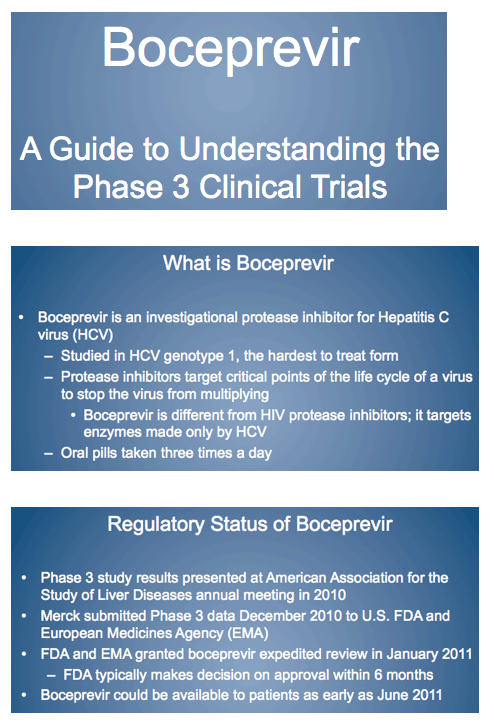
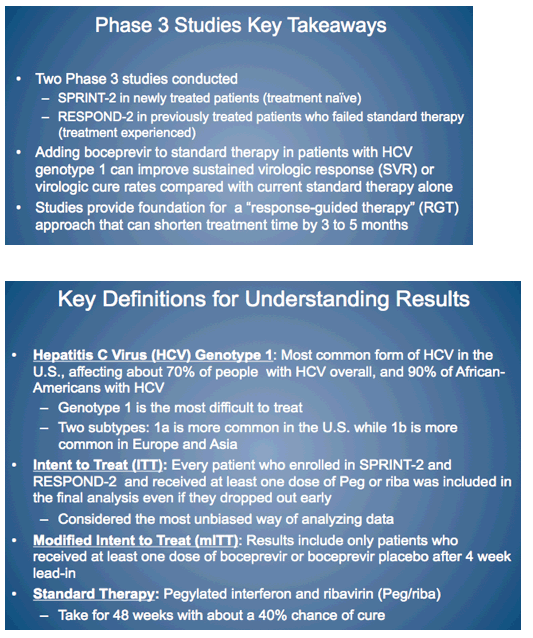
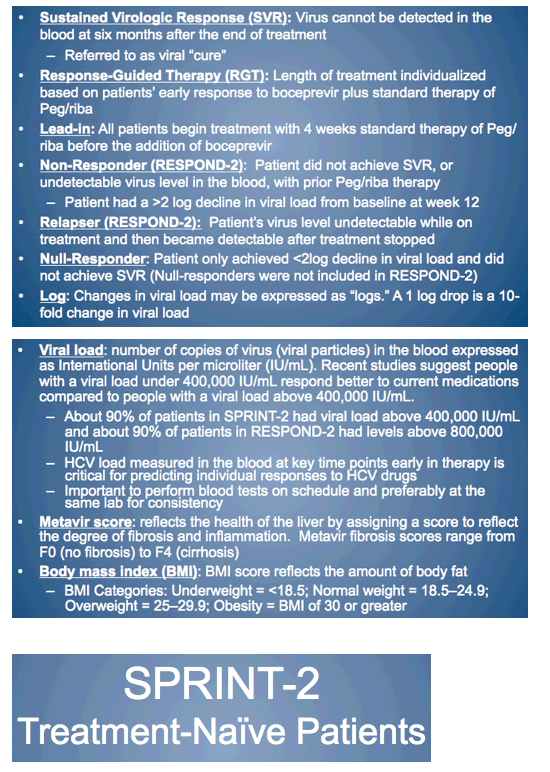
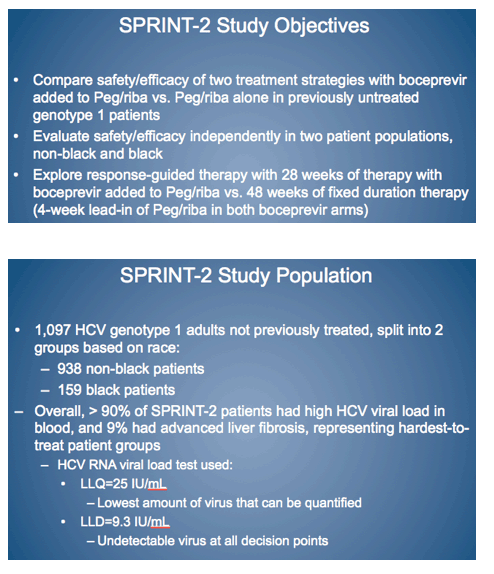
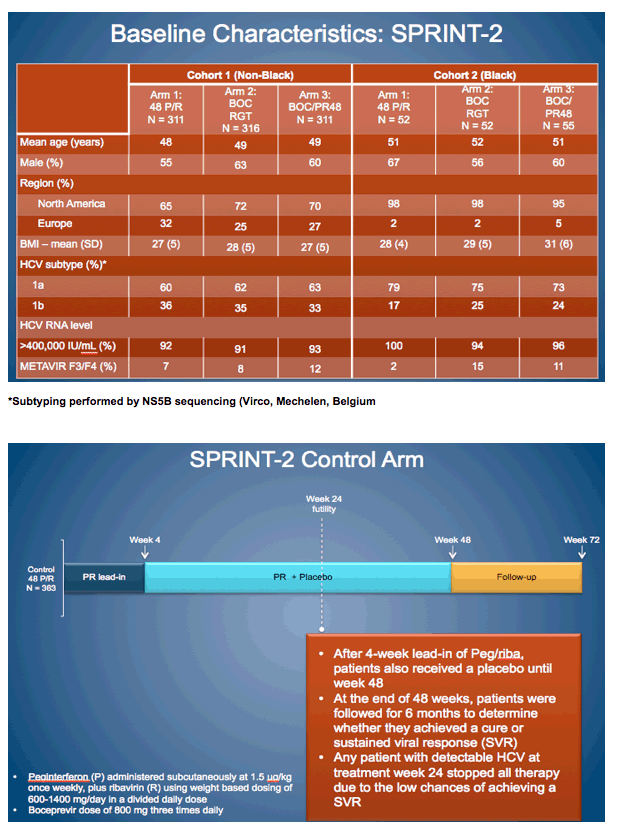
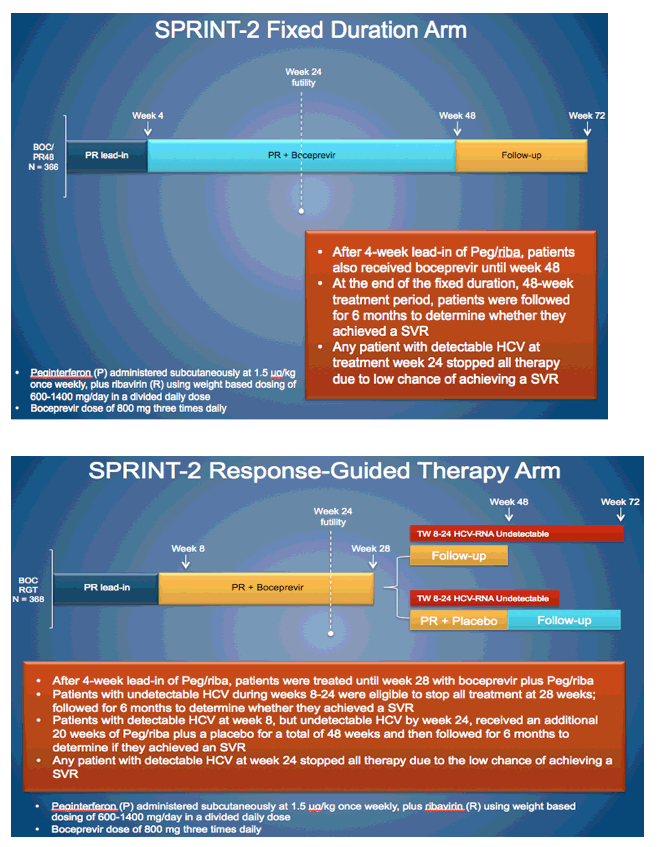
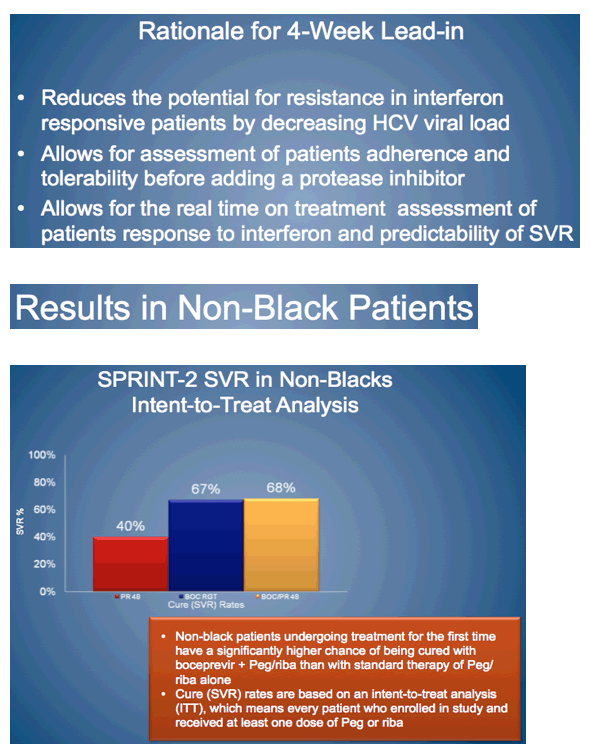
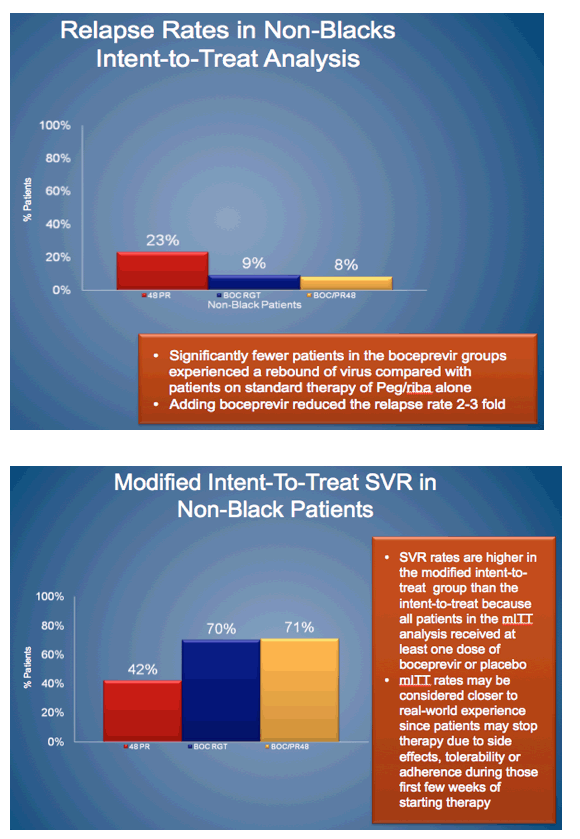
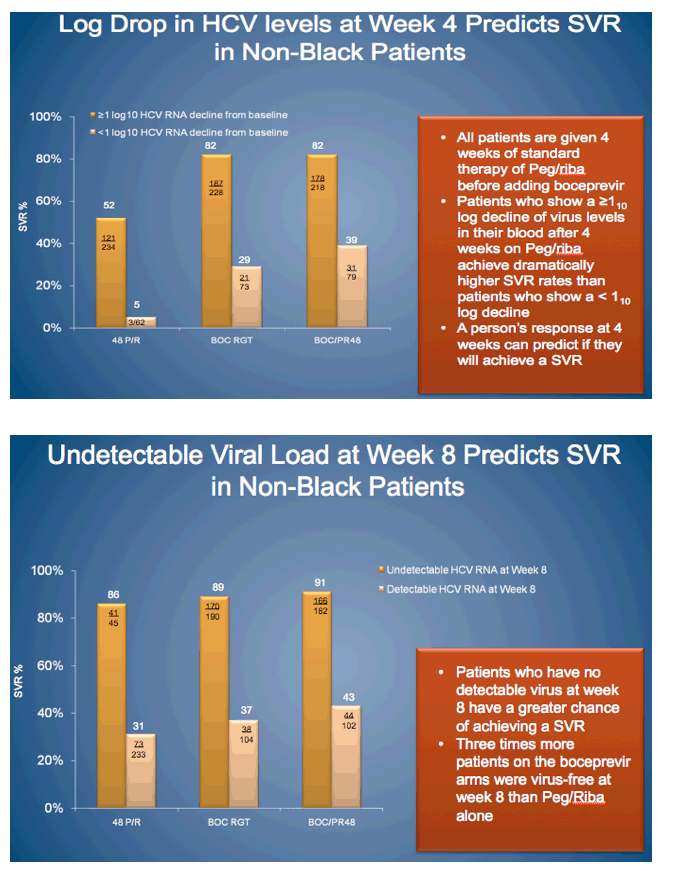
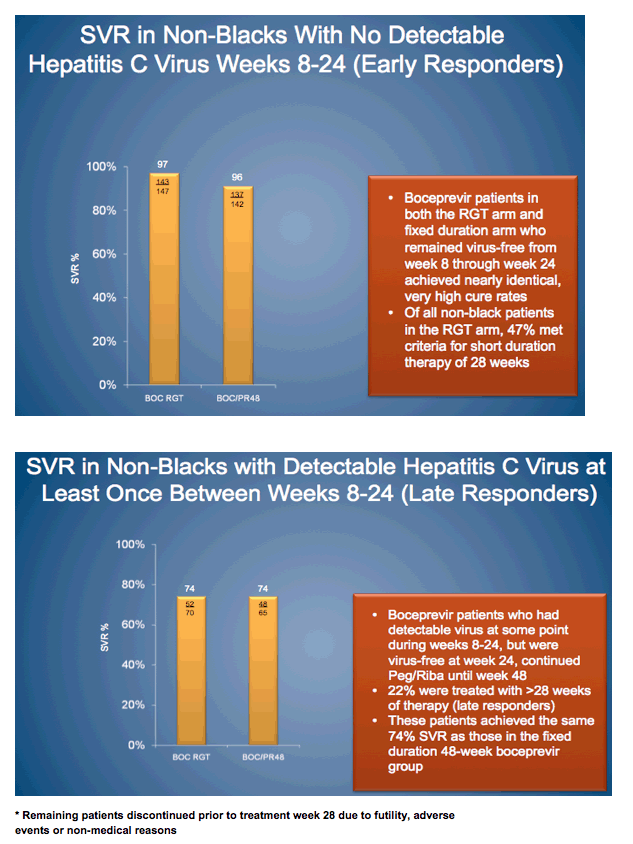
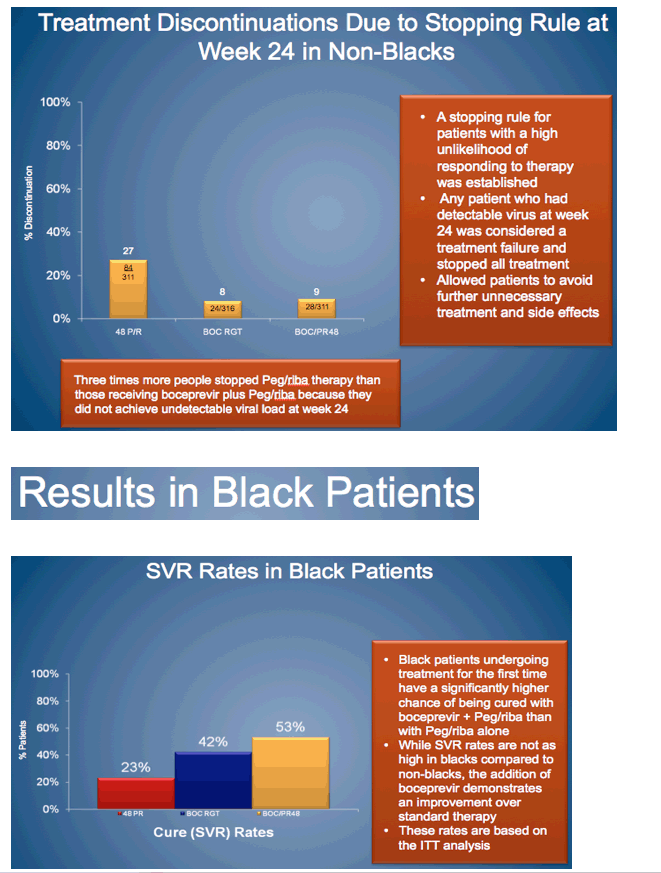

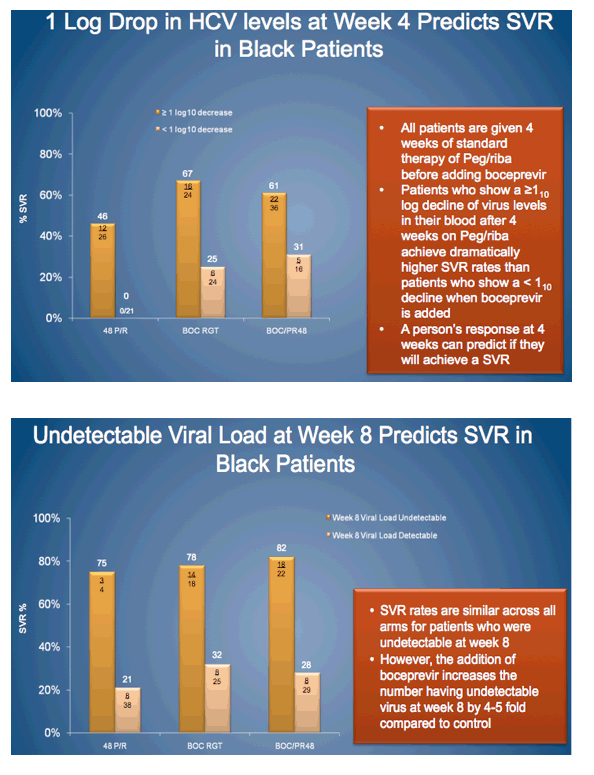
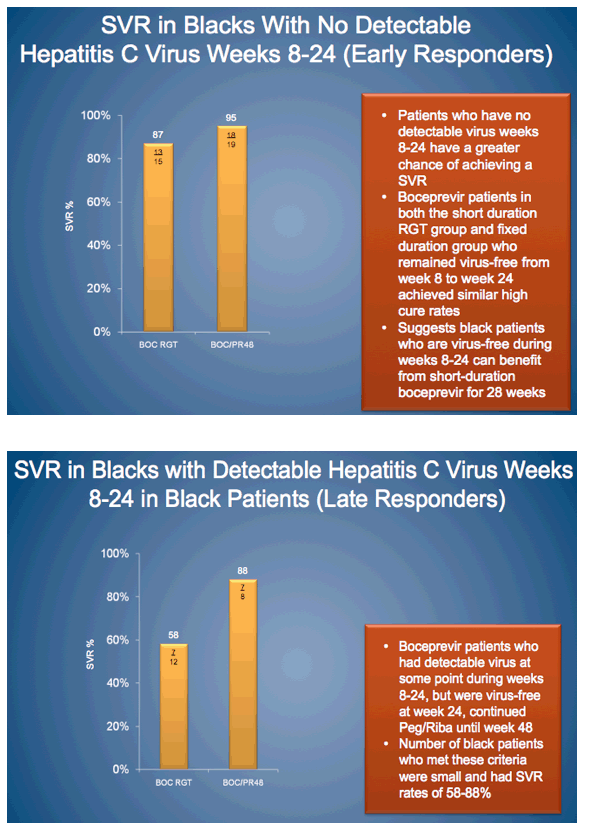
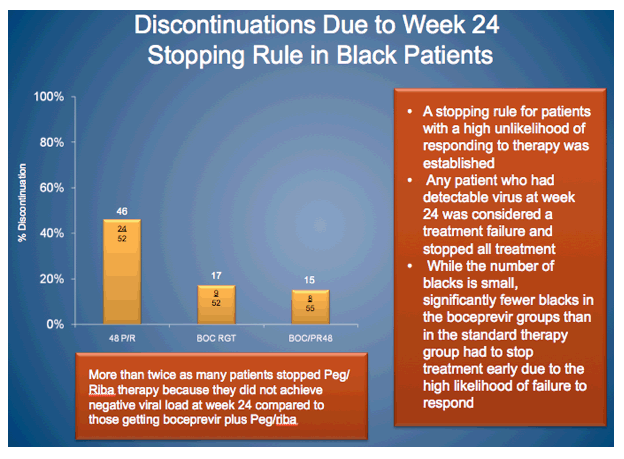
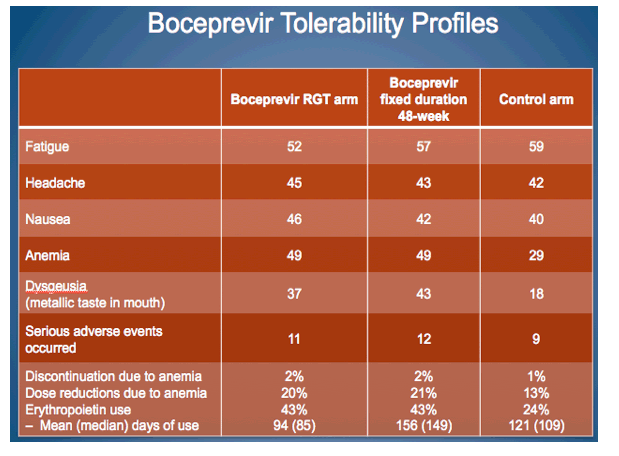
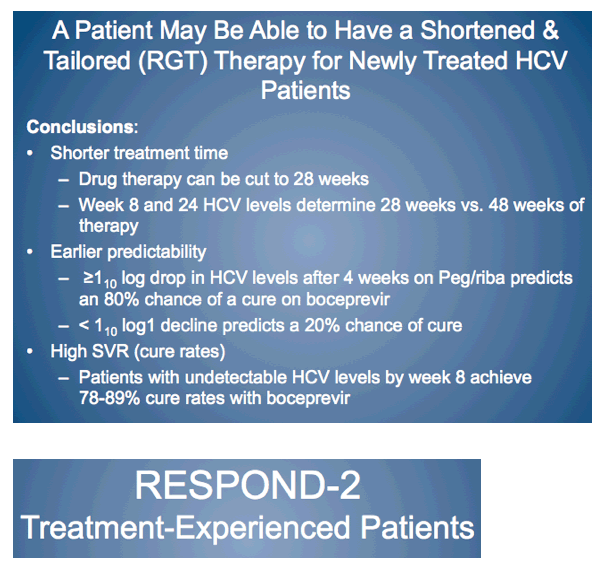



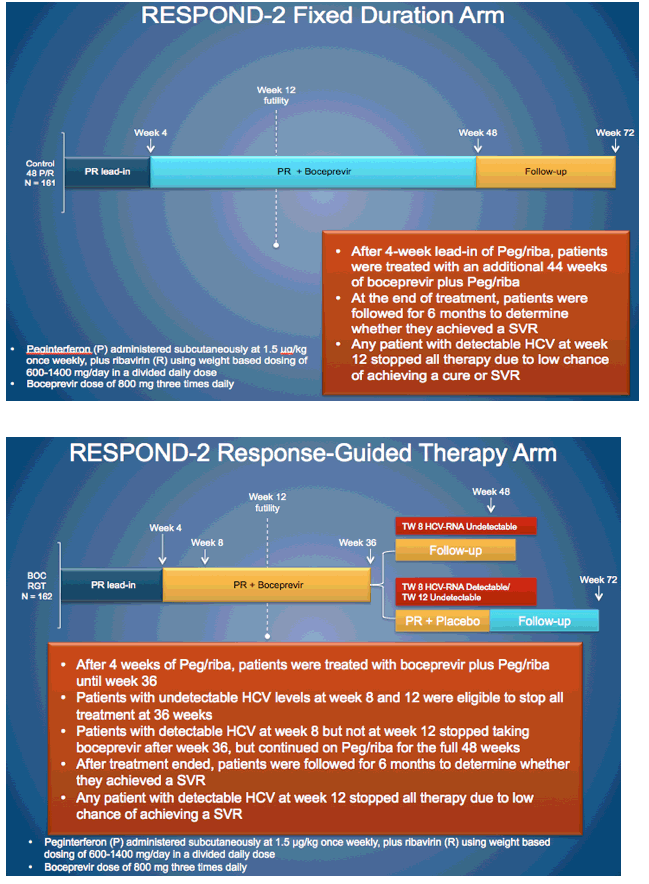
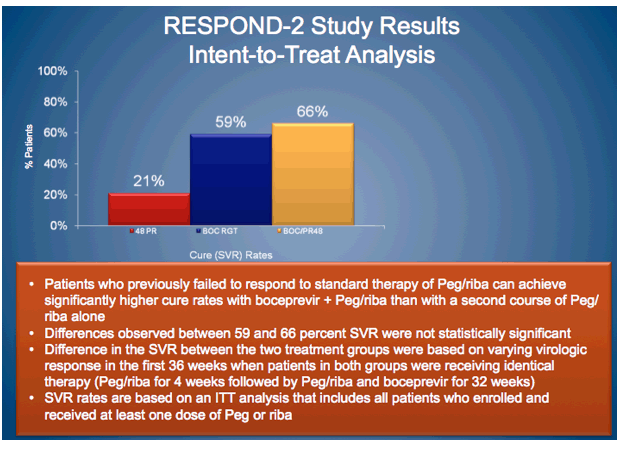

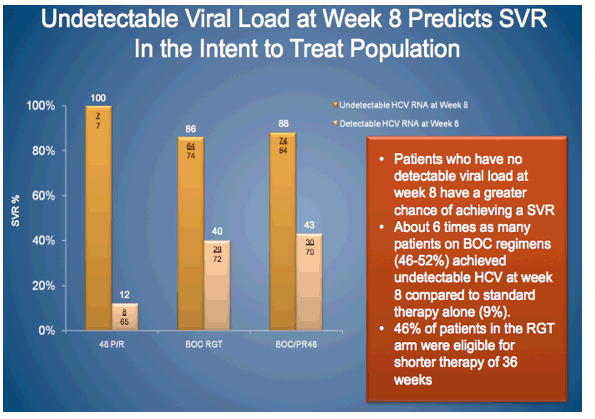

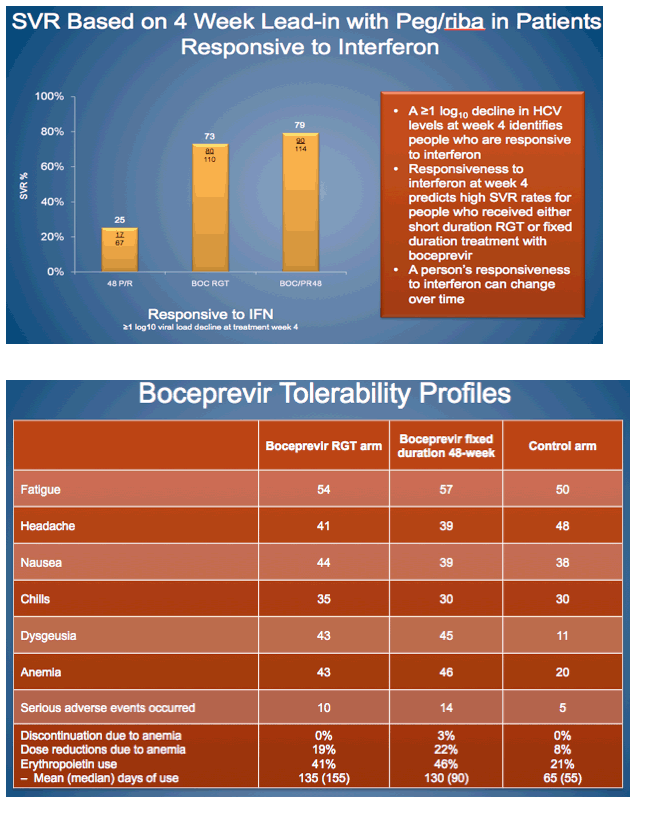
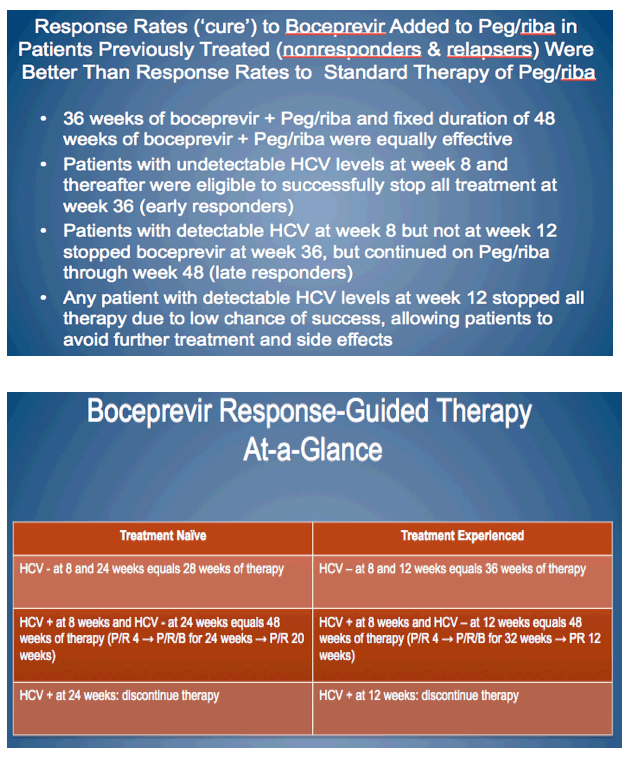
|
|
| |
| |
|
|
|